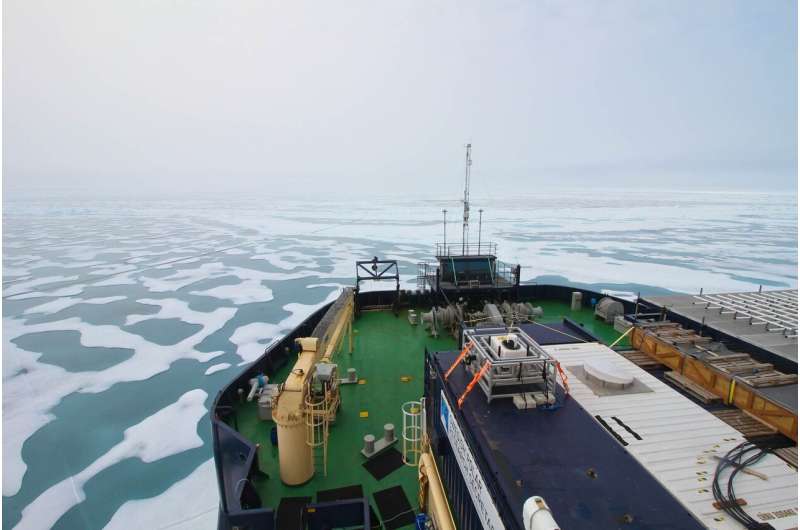Researchers make critical advances in quantifying methane released from the Arctic Ocean

A new study, lead by researchers at Stockholm University and published in Science Advances, now demonstrate that the amount of methane presently leaking into the atmosphere from the Arctic Ocean is much lower than previously claimed in recent studies. Methane is well known as a major contributor to global warming. Understanding the natural sources of this gas, especially in the fast-warming Arctic, is critical for understanding the future climate.
Compared with the amount of methane produced by human activities, the amount from the ocean was long thought to be negligible. Nevertheless, over the past decade, there have been reports claiming large amounts of methane emitted from the Arctic Ocean to the atmosphere. The amounts released were sometimes claimed to be catastrophically large and, even though the emissions had not been observed by atmospheric monitoring stations, it raised the question that perhaps scientists had missed something important about the Arctic Ocean's methane cycle. However, measuring small amounts of gas escaping from the sea and properly scaling the emissions over millions of square kilometers of the remote Arctic Ocean is not an easy task.
A unique application of an established measurement technique
In their study, the researchers used direct measurements of the methane sea-to-air flux to determine how much methane is leaking from the eastern Arctic Ocean to the atmosphere. They used data from the 2014 SWERUS-C3 project, during which the Swedish icebreaker Oden crossed the eastern Arctic Ocean from Tromsø, Norway.
Although other researchers have calculated the sea-to-air flux before, this study used a unique measurement technique to measure the fluxes directly, and the authors believe their paper is the first to successfully apply this method from a ship. The reason the method has not been used before is that it requires measuring the gas concentration in the atmosphere very rapidly—10 times per second—in addition to even faster measurements of the wind flow in three dimensions around the ship, and the precise location, acceleration and motion of the ship relative to the sea surface. Faster, smaller, accelerometers and inertial navigation units—similar to the chips which let smartphones know when you turn them sideways or upside down, as well as faster spectrometers for the methane measurement, and a detailed model of airflow around Oden, made this measurement possible.
"By understanding the airflow over the sea surface, and simultaneously measuring methane concentrations, we can determine how much methane is coming out of the ocean," explains researcher Brett Thornton at the Department of Geological Sciences, Stockholm University.
"This is actually our second paper on the topic of methane emissions from the sea during the SWERUS-C3 expedition. The method used then relied on slower measurements of methane in the surface water, and so we could not detect the largest 'hotspots' of emission as precisely," says Brett Thornton.
This new study shows that "hotspots" of methane emission from the sea can be up to 25 times higher than emissions from on-shore wetlands. These emissions are driven by bubbles coming from the seafloor and reaching the sea surface. This study directly observed very high peak emissions and, for the first time, was able to map their spatial extent.
"The peak emissions are indeed large but at the same time they are also extremely limited in area," says Brett Thornton.
Across the Laptev, East Siberian, and Chukchi seas the authors saw no evidence of widespread emissions at the magnitude of the "hotspots." In fact, their estimates for total methane emission from the eastern Arctic Ocean did not substantially increase even when they included these "hotspots" in the budget calculations.
"What this means is that—at least at the time of our measurements—the shallow eastern Arctic Ocean was not a huge source of methane to the atmosphere, and our understanding of Arctic sea emissions in the methane cycle is still reasonably correct. So this is, I would say, a bit of good news in the global warming story. Yes, there is methane leaking from the Arctic Ocean to the atmosphere. But, at least for now, it is not globally important to atmospheric methane and global warming," Brett Thornton explains.
It's important to realize that this work doesn't give insight into what might happen to these methane emissions in the future Arctic Ocean, with warmer waters and less ice cover. Will they increase or decrease? Will they become important globally? That remains to be determined by future research.
More information: Brett F. Thornton et al. Shipborne eddy covariance observations of methane fluxes constrain Arctic sea emissions, Science Advances (2020). DOI: 10.1126/sciadv.aay7934
Journal information: Science Advances
Provided by Stockholm University




















